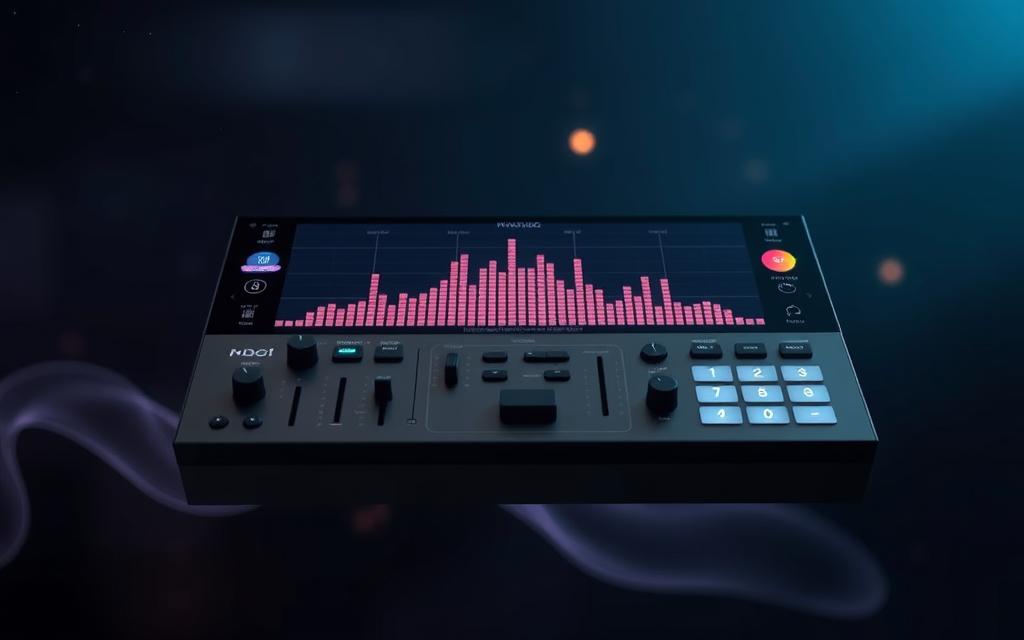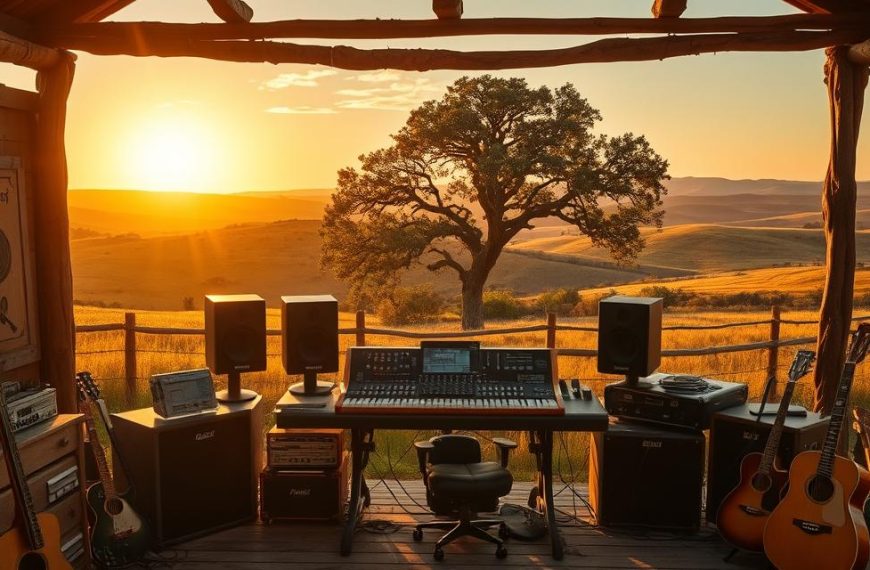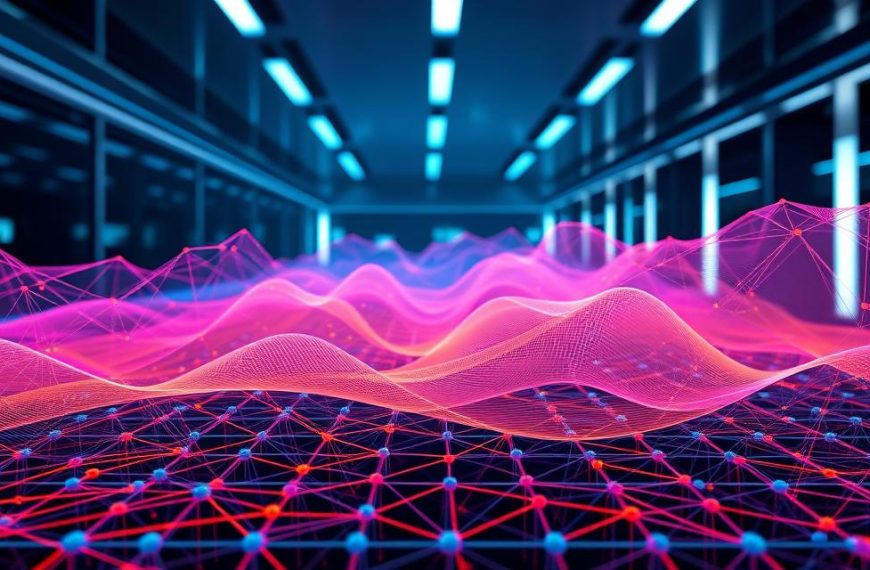Artificial Intelligence is changing the creative world, and music is leading the way. New ai music generator platforms have changed music making. They let us create in ways we never thought possible.
These advanced systems look at huge music collections to learn about patterns and sounds. They then make new songs that are as good as those made by humans. This has made music making open to everyone.
You don’t need to spend years learning or have expensive gear anymore. Today’s ai song maker tools help everyone, from beginners to pros. They are like creative friends that help us discover new sounds.
If you want to create ai music for fun or work, these tools are perfect. They bring together technology and creativity, opening up new ways for everyone to make music.
Overview of AI Music Generation Tools
The world of AI music creation has grown a lot. Now, creators have access to advanced tools for making music. These tools range from simple melody makers to systems that create full songs with vocals.
Today’s AI music tools are mainly two types. There are tools that make instrumental tracks and others that create full songs with music and lyrics. Knowing this helps creators pick the right tool for their projects.
Key Platforms for AI Song Creation
Many platforms lead in AI music creation. Each has special features and focuses. These tools are at the forefront of music AI.
OpenAI’s Jukebox: Capabilities and Uses
OpenAI’s Jukebox is a top system for making music in different styles. It uses a neural net to create raw audio in many genres. It can even mimic specific vocal styles.
This tool is great for making music in various styles. It’s perfect for experimental projects and studying music styles.
Amper Music: Features and Accessibility
Amper Music is easy to use and fast. It lets you make music quickly, even if you’re not a music expert. It’s good for both beginners and pros.
Its engine lets you change the mood, style, and length of your music right away. You can work on your music from any device, thanks to its cloud-based system.
AIVA: Specialisation in Classical Composition
AIVA focuses on classical and cinematic scores. It’s trained on classical music, so it makes real-sounding orchestral pieces.
It’s great for film scorers, game developers, and traditional composers. AIVA knows classical music well and adds modern touches to its compositions.
Selecting the Best Tool for Your Needs
Choosing the right AI music platform is important. You need to think about your goals, skills, and budget. The best tool should have the features you need for your projects.
Evaluating Genre Support and Customisation Options
Platforms support different genres and offer customisation options. Some focus on specific styles, while others cover more genres but with less detail.
Think about what genre you need and how much customisation you want. The best tools offer:
- Wide genre libraries with real sounds
- Options to adjust tempo, key, and instruments
- Ability to mix styles for new sounds
- Options to export for different mixing needs
Assessing Cost and User-Friendliness
Costs and ease of use vary among AI music tools. Some have free versions with basic features, while others require a subscription for more.
When comparing tools, look at both upfront costs and long-term value. Easy-to-use tools are best for quick projects.
| Platform | Primary Strength | Genre Specialisation | Pricing Model |
|---|---|---|---|
| OpenAI’s Jukebox | Artist style replication | Broad coverage | Research access |
| Amper Music | Rapid composition | Contemporary genres | Subscription-based |
| AIVA | Classical composition | Orchestral/Cinematic | Freemium model |
| Soundraw | Instrumental tracks | Multiple genres | Monthly subscription |
| Boomy | Full song creation | Popular music | Free with premium features |
This table helps you find the right AI music tool for you. The best choice depends on your musical goals, skills, and preferences.
Many tools offer free trials or limited free versions. Trying them out is the best way to see if they fit your needs.
Preparing to Ask AI to Make a Song
Before you start using AI music tools, it’s important to prepare well. Good preparation helps the AI understand what you want. This makes sure the music fits your vision perfectly.
Defining Your Musical Vision
Setting clear goals is key. It tells the AI what kind of music to make. Without this, you might get music that’s not what you expected.
Establishing Genre, Tempo, and Mood
First, choose your music style. It could be pop, classical, or EDM. This tells the AI what kind of music to create.
Then, pick the tempo. A slower tempo makes music calm, while a faster one makes it lively.
Lastly, decide on the mood. Do you want the music to be happy, sad, or something else? These choices are the base of your song.
Drafting Lyrics and Melodic References
For songs with vocals, write down your lyrics. Even a few lines help the AI understand your song.
If you have a tune in mind, hum or whistle it. This helps the AI get your musical idea.
Gathering Necessary Inputs and Resources
Having the right materials makes creating music easier. Organised resources help you work better with AI tools.
Tips for Effective Prompt Crafting
Writing clear prompts is vital for good AI music. Here are some tips:
- Use specific words: “ethereal pads with pulsating bassline”
- Mention famous artists: “in the style of Daft Punk”
- Combine styles: “jazz chords with hip-hop drums”
- Specify instruments: “feature acoustic guitar and piano”
- Describe the song’s flow: “build from quiet intro to explosive chorus”
Good prompts are specific but also let the AI be creative. They guide the AI without limiting it too much.
Organising Audio Samples or MIDI Files
Collect any music bits you want to use. Good preparation makes working with AI easier.
Audio samples can inspire or be used directly by AI. Make sure to label them by tempo, key, and mood.
MIDI files give you control over the music. Many AI tools can work with MIDI sequences you provide.
| Resource Type | Preparation Tip | AI Integration Method |
|---|---|---|
| Audio Samples | Label with BPM and key | Use as reference or input |
| MIDI Files | Organise by instrument type | Import for modification |
| Lyric Sheets | Format with verse/chorus labels | Copy-paste into text fields |
| Reference Tracks | Note timestamped sections | Describe elements to emulate |
Organising your work might seem hard, but it’s worth it. The effort you put in at the start affects how well the AI music fits your vision.
Step-by-Step: Asking AI to Make a Song
First, pick your favourite AI music platform and get your creative stuff ready. Then, you’re all set to start the ai song generation process. This guide will show you the key steps to create ai song using today’s AI tools.
Step 1: Accessing and Setting Up Your Chosen AI Tool
Start by going to your chosen platform’s website. Most services are available online or as downloadable software. You’ll need to create an account with your email and a password.
Creating an Account and Navigating the Interface
After verifying your account, get to know the workspace. Tools like ACE Studio have a layout similar to digital audio workstations. You’ll find transport controls, a piano roll editor, and an AI singer library.
Explore the menu and toolbar options. Knowing the layout well makes using AI for music easier later.
Step 2: Inputting Parameters and Preferences
This step is where you set the basics of your song. The more specific you are, the better the results.
Configuring Settings for Genre and Instrumentation
Start by choosing:
- Primary genre (pop, rock, electronic, etc.)
- Tempo measured in BPM (beats per minute)
- Key signature and scale type
- Time signature (4/4, 3/4, etc.)
- Instrumentation preferences
Platforms like Soundful have templates for different genres. They automatically set these settings for you.
Entering Lyrical and Melodic Inputs
For tools with vocal generation, choose an AI singer and enter lyrics. Some allow melody input via MIDI keyboard or piano roll editor.
Inputting chord progressions or melodies helps guide the AI. The more you provide, the closer it will be to your vision.
Step 3: Initiating the Generation Process
With everything set, it’s time to let the AI do its magic. This is when your inputs turn into a complete song.
Executing the AI Request and Monitoring Progress
Click the generate or create button to start. Most interfaces show how far along the AI is. Some even offer real-time previews.
Don’t change your settings while the AI works. Let it finish its task without interruption.
Expected Timeframes for Output Delivery
Generation times vary based on several factors:
| Complexity Level | Platform | Average Generation Time |
|---|---|---|
| Basic (melody only) | Soundful | 15-30 seconds |
| Intermediate (full arrangement) | Most platforms | 1-3 minutes |
| Advanced (with AI vocals) | ACE Studio | 3-8 minutes |
Longer times mean more complex processing and better quality. The wait is worth it.
After it’s done, your song will be in your project library. Most platforms save your work in the cloud for easy access.
Refining the AI-Generated Composition
Once your AI music generator has created its first draft, the real fun starts. This stage turns raw computer sounds into something that shows off your unique style.
Analysing the Initial Output
Start by listening to your AI track over and over. Note down what you like and what could be better. Think about the track’s flow and how it makes you feel.
Identifying Areas for Improvement
AI music often has repetitive melodies, awkward parts, and sounds too generic. Look out for places where the energy falls or the instruments don’t sound right together.
AI lyrics might sound unnatural or have themes that don’t match. A human eye can make these changes better.
Editing Techniques for Enhancement
Most AI music tools have editing features that let you tweak your work. These tools are key to making your music truly yours.
Adjusting Melody, Harmony, and Structure
Use the MIDI editor to change note details. Even small tweaks to melodies can make a big difference in how your track feels.
Try rearranging parts to improve the flow. Moving a chorus or bridge can turn a good song into a great one.
Incorporating Human Performances or Tweaks
Adding real instruments or vocals can take AI music to the next level. Try recording guitar, piano, or vocals over the AI base.
Manual mixing can also enhance your track. Adjusting EQ, adding effects, or tweaking levels can make it sound more polished.
Combining AI’s efficiency with your creativity is the secret to success. Your personal touches make the music stand out.
Legal Aspects of AI-Generated Music
Creating music with AI is exciting but raises legal questions. It’s key to know your rights and duties in the copyright ai music world.
Understanding Copyright and Ownership
AI music raises new copyright challenges. Unlike human-made music, AI’s work doesn’t have a clear creator. This makes it hard to figure out ownership of ai songs and who has the rights.
Most platforms give users certain rights through their terms. But, these rights differ a lot between AI music tools.
Platform-Specific Policies on Rights
Different AI music services handle rights differently. Some let you use music commercially, while others have limits.
ACE Studio’s Creative Library offers royalty-free vocal samples for use. Soundful lets users download tracks royalty-free, based on their subscription. These examples show how platforms deal with AI music’s legal issues.
Always check a platform’s terms before using AI music for commercial purposes. Here’s a table comparing rights policies on major AI music platforms:
| Platform | Commercial Usage | Royalty Status | Attribution Required |
|---|---|---|---|
| ACE Studio | Allowed | Royalty-free | No |
| Soundful | Subscription-dependent | Royalty-free | No |
| Amper Music | Allowed with licence | Royalty-free | Yes |
| AIVA | Professional plan required | Royalty-free | Yes |
Ethical Practices in AI Song Creation
Ethical ai composition means more than just following the law. It’s about respecting original artists and being open about your creative process.
As this legal analysis shows, the music industry is figuring out copyright laws for AI. Until then, being ethical is even more vital.
Avoiding Infringement and Giving Credit
To avoid copyright issues, make sure your AI music doesn’t copy existing works too closely. Most platforms have checks, but creators should be careful.
When it’s right, say how AI helped in your music. This honesty builds trust and supports ethical ai composition.
Here are some tips for ethical AI music making:
- Check if your music is too similar to others
- Know and follow platform rules
- Share AI’s role in your music with your audience
- Keep up with changing AI music laws
By following these tips, you can handle copyright ai music issues while staying ethical in your work.
Advanced Tips for Optimal Results
For top-notch results, artists should try advanced layering with multiple AI tools. These advanced AI music techniques help make your music richer and more detailed. Your tracks will be far better than those made by basic AI.
Leveraging Multiple AI Tools for Layering
Using different AI platforms for various music parts is a smart move. For example, use one tool for drums, another for chords, and ACE Studio for vocals. This way, you pick the best tool for each part of your song.
Once you’ve made these parts, mix them in your Digital Audio Workstation (DAW). This layering AI tools method adds depth and texture. You get to keep control while using each tool’s special abilities.
Iterative Approaches for Complex Compositions
Creating complex AI compositions needs a back-and-forth process. Begin with an AI idea, then use it to inspire more work. Take the first output and add it to other AI tools or human-made parts.
This loop helps your music grow naturally. Each step makes it more detailed and unique. Feel free to mix genres for fresh sounds that don’t fit into one category.
For those wanting to grow in electronic music, check out our guide to electronic music production with AI. It’s full of tips and techniques.
Always mix AI outputs with professional music production plugins for the final touch. EQ, compression, and effects can make AI music sound ready for the radio. It shows off both tech and artistry.
Conclusion
This guide has covered AI song creation from start to finish. It shows how easy it is to make music with artificial intelligence.
AI music tools save time, spark creativity, and help all musicians. They let creators try new sounds and styles easily.
Looking ahead, AI in music is getting even better. Tools like OpenAI’s Jukebox and Google’s MusicLM are just the start.
We suggest mixing AI with your own creativity. The best music comes from combining human talent with AI’s help.
Keep trying out these AI tools as they get better. The world of AI-assisted music is full of new ideas and ways to express yourself.


















